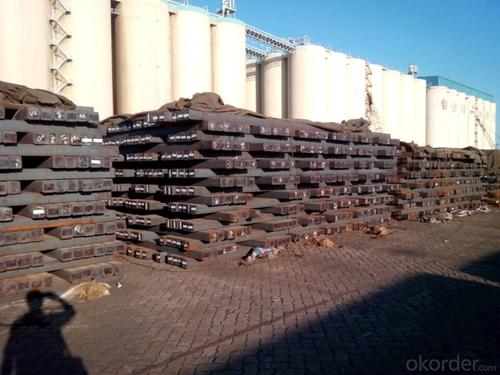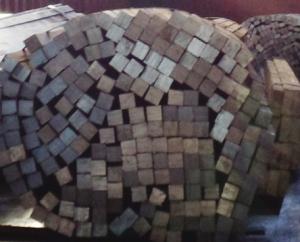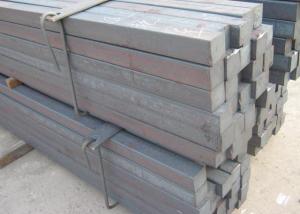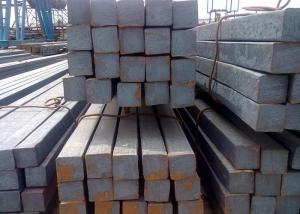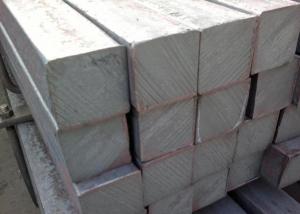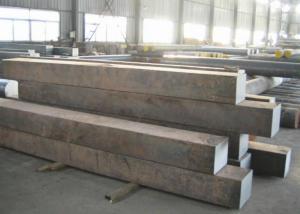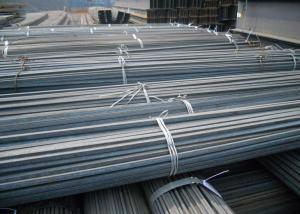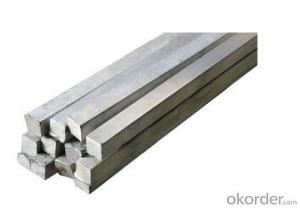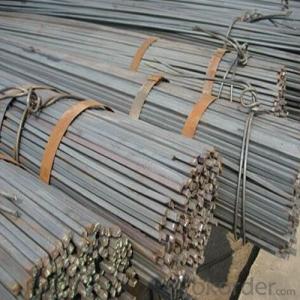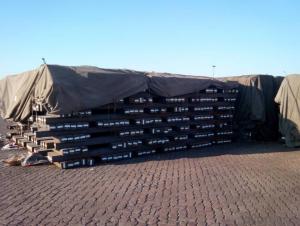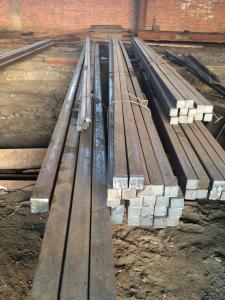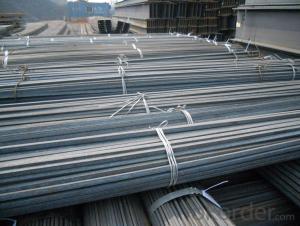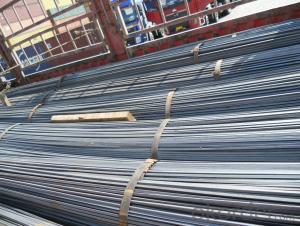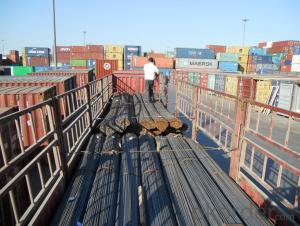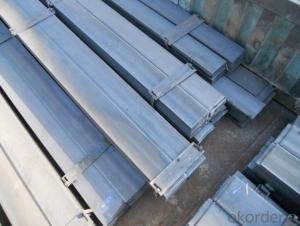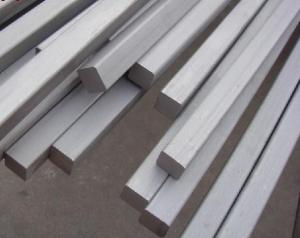Hot Rolled Square Carbon Steel Bar Material Q235
- Loading Port:
- Qingdao
- Payment Terms:
- TT or LC
- Min Order Qty:
- 25 m.t.
- Supply Capability:
- 3000 m.t./month
OKorder Service Pledge
OKorder Financial Service
You Might Also Like
Product Description:
OKorder is offering Hot Rolled Square Carbon Steel Bar at great prices with worldwide shipping. Our supplier is a world-class manufacturer of steel, with our products utilized the world over. OKorder annually supplies products to European, North American and Asian markets. We provide quotations within 24 hours of receiving an inquiry and guarantee competitive prices.
Product Applications:
The Square Steel is normally used as structure steel.
Row material for other structure steel like steel angles, channels, I-beams, H-beams, etc…
Product Advantages:
OKorder's Hot Rolled Square Steel Bar Material Q195 are durable, strong, and resist corrosion.
Main Product Features:
· Premium quality
· Prompt delivery & seaworthy packing (30 days after receiving deposit)
· Corrosion resistance
· Can be recycled and reused
· Mill test certification
· Professional Service
· Competitive pricing
Product Specifications:
Length of a side(mm) | Theoretical weight(kg/m) | Length of a side(mm) | Theoretical weight(kg/m) |
6 | 0.283 | 32 | 8.04 |
7 | 0.385 | 33 | 8.55 |
8 | 0.502 | 34 | 9.07 |
9 | 0.636 | 35 | 9.62 |
10 | 0.785 | 36 | 10.17 |
11 | 0.950 | 38 | 11.24 |
12 | 1.13 | 40 | 12.56 |
13 | 1.33 | 42 | 13.85 |
14 | 1.54 | 45 | 15.90 |
15 | 1.77 | 48 | 18.09 |
16 | 2.01 | 50 | 19.63 |
17 | 2.27 | 53 | 22.05 |
18 | 2.54 | 55 | 23.6 |
19 | 2.82 | 56 | 24.61 |
20 | 3.14 | 58 | 26.4 |
21 | 3.46 | 60 | 28.26 |
22 | 3.80 | 63 | 31.16 |
23 | 4.15 | 65 | 33.17 |
24 | 4.52 | 68 | 36.3 |
25 | 4.91 | 70 | 38.49 |
26 | 5.30 | 75 | 44.16 |
27 | 5.72 | 80 | 50.24 |
28 | 6.15 | 85 | 56.72 |
29 | 6.60 | 90 | 63.59 |
30 | 7.06 | 95 | 70.85 |
31 | 7.54 | 100 | 78.50 |
Notes:
1, The theoretical weights in the list, base on the density of 7.85 g/cm3.
2, The numbers with mean that they are not regulars or we don’t offer them.
-List 2. The allowed tolerance of Square Steel:
Length of a side(mm) | Allowed Tolerance | ||
Group1 | Group2 | Group3 | |
5.5~7 | ±0.20 | ±0.30 | ±0.40 |
7~20 | ±0.25 | ±0.35 | ±0.40 |
20~30 | ±0.30 | ±0.40 | ±0.50 |
30~50 | ±0.40 | ±0.50 | ±0.60 |
60~80 | ±0.60 | ±0.70 | ±0.80 |
80~110 | ±0.90 | ±1.0 | ±1.1 |
110~150 | ±1.2 | ±1.3 | ±1.1 |
150~190 | ―― | ―― | ±2.0 |
190~250 | ―― | ―― | ±2.5 |
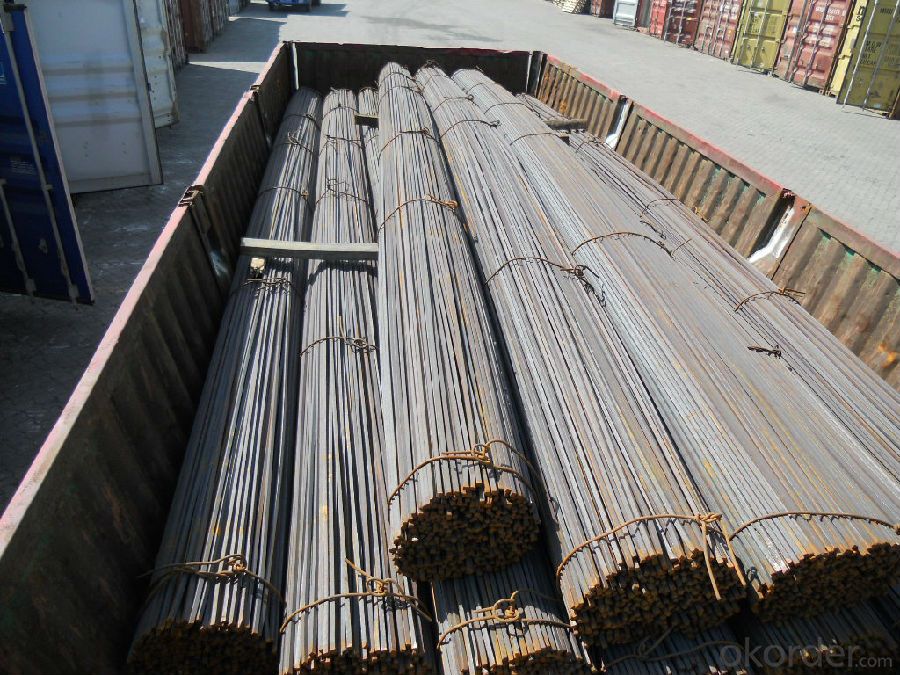
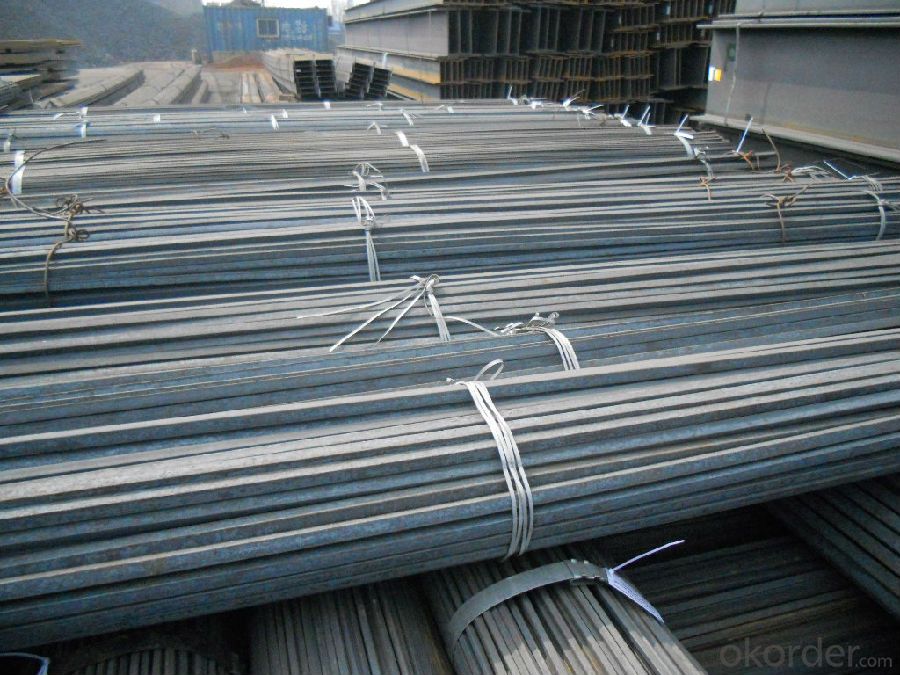
FAQ:
Q1: Why buy Materials & Equipment from OKorder.com?
A1: All products offered byOKorder.com are carefully selected from China's most reliable manufacturing enterprises. Through its ISO certifications, OKorder.com adheres to the highest standards and a commitment to supply chain safety and customer satisfaction.
Q2: How do we guarantee the quality of our products?
A2: We have established an advanced quality management system which conducts strict quality tests at every step, from raw materials to the final product. At the same time, we provide extensive follow-up service assurances as required.
Q3: How soon can we receive the product after purchase?
A3: Within three days of placing an order, we will begin production. The specific shipping date is dependent upon international and government factors, but is typically 7 to 10 workdays.
Q4: What makes stainless steel stainless?
A4: Stainless steel must contain at least 10.5 % chromium. It is this element that reacts with the oxygen in the air to form a complex chrome-oxide surface layer that is invisible but strong enough to prevent further oxygen from "staining" (rusting) the surface. Higher levels of chromium and the addition of other alloying elements such as nickel and molybdenum enhance this surface layer and improve the corrosion resistance of the stainless material.
- Q: How do you use a steel square to determine the angle of a cut?
- To use a steel square to determine the angle of a cut, you would place the square against the material being cut, aligning one edge of the square with the edge of the material. Then, you can read the angle measurement indicated on the square's scale or protractor. This will give you the precise angle for making the cut.
- Q: How is a steel square used in carpentry?
- A steel square, also known as a framing square or carpenter's square, is a versatile tool that is widely used in carpentry for various purposes. It consists of two arms, typically 24 inches long, joined at a right angle. One arm is called the blade, and the other is called the tongue. One of the most common uses of a steel square in carpentry is for determining and marking right angles. Carpenters use it to ensure that corners and joints are perfectly square. By placing the square against a board or surface, they can confirm if the angles are 90 degrees. If not, adjustments can be made accordingly to ensure accuracy and precision in the construction process. In addition to checking right angles, a steel square is also used for measuring and marking cuts. The blade of the square is marked with various measurements, such as inches and centimeters, allowing carpenters to take precise measurements quickly. This helps in accurately marking the length and width of boards or pieces that need to be cut, ensuring proper fitment and reducing errors. Another application of a steel square is for laying out and marking angles other than 90 degrees. The tongue of the square is marked with degree increments, making it easy for carpenters to measure and mark angles of different degrees. This is particularly useful when working on projects that require angled cuts, such as roof rafters or staircases. Furthermore, a steel square can be used as a guide for making straight cuts with a circular saw or jigsaw. By aligning the blade of the saw against the blade of the square, carpenters can ensure a straight and accurate cut. Overall, a steel square is an indispensable tool in carpentry, providing carpenters with the ability to check right angles, measure and mark cuts, and lay out angles with precision. Its versatility and accuracy make it an essential tool for both professional carpenters and DIY enthusiasts.
- Q: Can a steel square be used for checking the levelness of shelves?
- No, a steel square cannot be used for checking the levelness of shelves. A steel square, also known as a framing square, is primarily used in carpentry and woodworking to measure and mark angles and to ensure the accuracy of right angles. It is not designed or suitable for checking the levelness of shelves. To check the levelness of shelves, a level tool such as a spirit level or a laser level should be used. These tools are specifically designed to determine if a surface is perfectly horizontal or level. They provide a much more accurate and reliable measurement for ensuring the levelness of shelves.
- Q: How do you use a steel square to check for squareness?
- To use a steel square to check for squareness, you would typically follow these steps: 1. Place the steel square on a flat surface, such as a workbench or table, ensuring that it is resting firmly and evenly. 2. Align one edge of the steel square against the surface you want to check for squareness. This could be the edge of a piece of wood, a wall, or any other object that should be at a perfect 90-degree angle. 3. Observe the corner where the two edges of the steel square meet. If the object you are checking is square, the two edges should form a perfect 90-degree angle. 4. To ensure accuracy, you can use a measuring tape or ruler to measure the distance between the two edges of the steel square at different points along the edges. The measurements should be equal if the object is square. 5. Repeat the process on different sides or corners of the object to ensure overall squareness. If the steel square consistently shows a perfect 90-degree angle, then the object is square. It is important to note that while a steel square is a reliable tool for checking squareness, it is crucial to have a flat and even surface to ensure accurate results. Additionally, some steel squares may have additional features, such as a level or a lip, which can provide further assistance in checking for squareness.
- Q: What are the uses of a steel square in construction?
- A steel square, also known as a framing square or carpenter's square, is a versatile tool widely used in construction for various purposes. Some of the key uses of a steel square in construction are: 1. Measuring and marking: A steel square is primarily used for measuring and marking straight lines and angles accurately. It consists of two arms, one long and one shorter, forming a right angle. This allows for precise measurements and marking of 90-degree angles, ensuring straight and square cuts. 2. Layout and framing: Steel squares are essential for layout work in construction projects. They help carpenters and builders lay out and mark building components, such as walls, roofs, stairs, and door frames, ensuring proper alignment and dimensions. The square's edges and measurements allow for precise layout and framing, resulting in well-built structures. 3. Cutting and sawing: Steel squares are often used as a guide for cutting and sawing materials. By aligning the square with the edge of the material, it provides a straight and accurate reference line for cutting with a saw or other tools. This helps prevent errors and ensures clean and precise cuts, especially for tasks like cross-cutting or mitering. 4. Checking and testing: Steel squares are useful for checking and testing the accuracy and squareness of existing structures or finished components. By comparing the square's edges against existing angles or corners, builders can identify any discrepancies or misalignment that need correction. This helps maintain the structural integrity and overall quality of construction projects. 5. Plumbing and leveling: In addition to measuring angles, steel squares can also be used for plumbing and leveling tasks. For example, when installing cabinets or shelves, a square can be used to ensure the vertical alignment of the components. It can also be used to check the levelness of surfaces, such as countertops or floors, by comparing the square's edges to the surface. Overall, a steel square is an essential tool in construction due to its versatility and accuracy. Its uses range from measuring and marking to layout, cutting, checking, and leveling, making it indispensable for builders, carpenters, and other construction professionals.
- Q: Can a steel square be used for checking the levelness of a countertop?
- No, a steel square cannot be used for checking the levelness of a countertop. A steel square is primarily used for measuring and marking right angles in woodworking or metalworking projects. To check the levelness of a countertop, a level tool or a straight edge would be more appropriate. These tools are specifically designed to determine if a surface is level or not by indicating if it is parallel to the ground. Using a steel square for this purpose would not provide accurate results and could potentially lead to an uneven or improperly installed countertop.
- Q: How do you use a steel square for creating accurate corner lap joints?
- To create accurate corner lap joints using a steel square, first, align one edge of the square with the end of the board and mark the desired length on the board. Then, slide the square along the board's length, ensuring the square's edge remains aligned with the end. Continue marking the desired length until you reach the corner. Next, align the square's shorter arm with the previously marked line and draw a perpendicular line across the board. Repeat this process on the adjoining board. Finally, cut along the marked lines to create precise corner lap joints. The steel square helps maintain the accuracy and squareness of the joints throughout the process.
- Q: What are the common materials used to make a steel square?
- The common materials used to make a steel square are typically stainless steel, carbon steel, or tool steel. These materials are chosen for their strength, durability, and resistance to corrosion. Stainless steel is often preferred as it offers excellent resistance to rust and staining, making it ideal for outdoor use or in humid environments. Carbon steel is another commonly used material for steel squares due to its affordability and high tensile strength. Tool steel, which is a high-carbon alloy steel, is often used in specialized squares designed for precision measurements and heavy-duty applications. Overall, the choice of material depends on the intended use and the specific requirements of the steel square.
- Q: Can a steel square be used for tile layout?
- Tile layout can definitely benefit from the use of a steel square. This tool, also referred to as a framing square or a carpenter's square, is incredibly versatile and has many applications in layout tasks. One of its main uses is for marking right angles and checking for squareness. When it comes to tile layout specifically, a steel square is great for ensuring that tiles are laid out in straight lines and at perfect right angles. It can also be used to measure and mark the starting point for tile installation, as well as to verify if the tiles are properly aligned and square throughout the installation process. However, it's important to remember that while a steel square is useful, it should be utilized alongside other tile layout tools like a chalk line or a laser level. This combination guarantees accurate and precise tile installation.
- Q: Can a steel square be used for measuring the height of a flagpole?
- No, a steel square cannot be used for measuring the height of a flagpole. A steel square, also known as a try square, is a tool used primarily for measuring and marking angles of 90 degrees. It is not designed or equipped to measure vertical distances or heights. To measure the height of a flagpole, one would typically use a measuring tape, a laser distance meter, or some other device specifically designed for measuring vertical distances.
Send your message to us
Hot Rolled Square Carbon Steel Bar Material Q235
- Loading Port:
- Qingdao
- Payment Terms:
- TT or LC
- Min Order Qty:
- 25 m.t.
- Supply Capability:
- 3000 m.t./month
OKorder Service Pledge
OKorder Financial Service
Similar products
Hot products
Hot Searches
Related keywords




